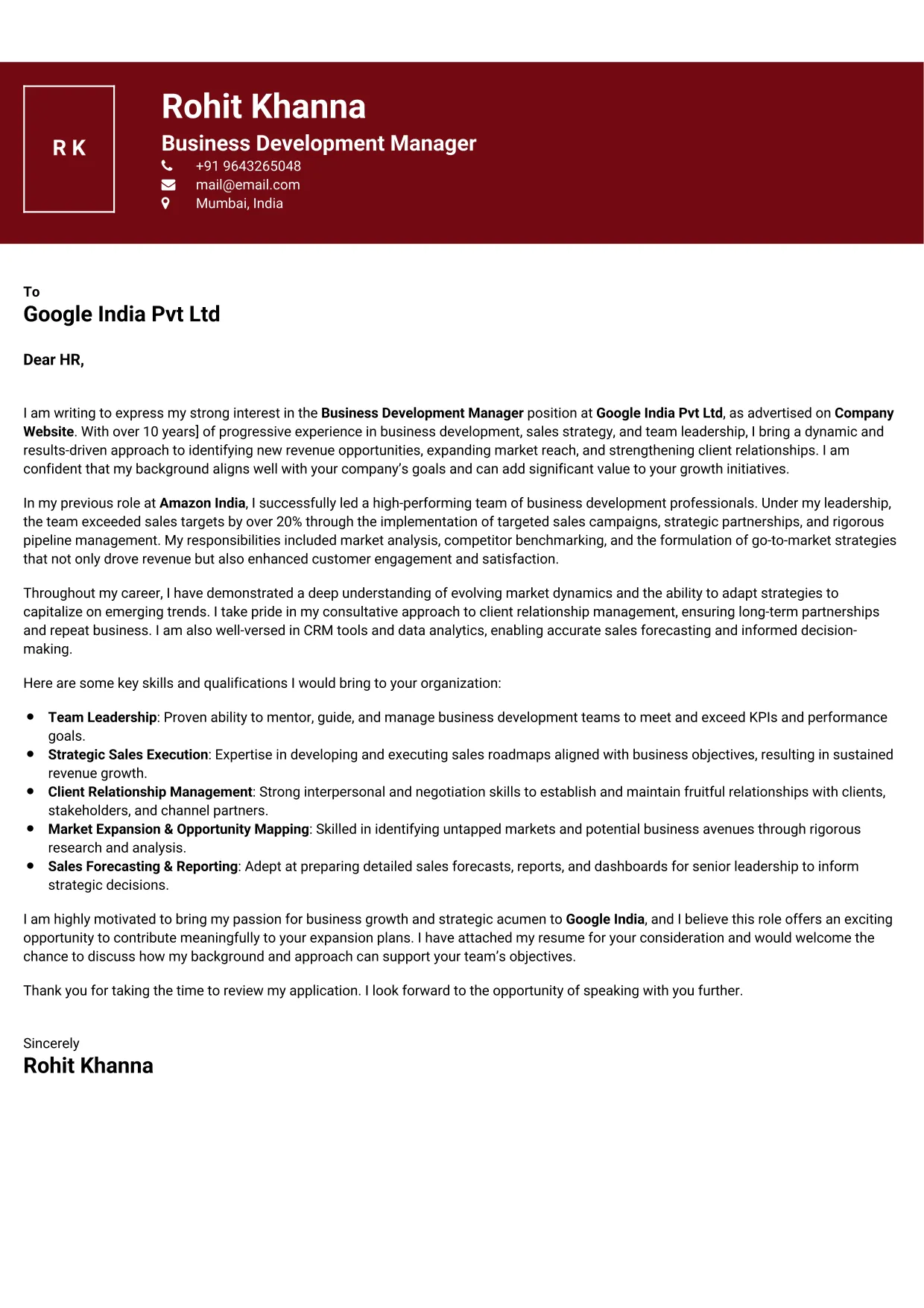Executive Recruiter
Welcome to our Executive Recruiter cover letter sample page! This professionally designed template is crafted to highlight your expertise in identifying, attracting, and securing top-tier leadership talent. Whether you're working in an agency, in-house, or as a retained search consultant, this sample emphasizes key skills like executive search methodologies, candidate pipeline development, client relationship management, and sophisticated negotiation. Tailored to meet 2025 employer expectations, this guide will help you create a compelling cover letter that stands out in the competitive talent acquisition landscape and secures your next high-impact role.
Superbresume.com empowers Executive Recruiters to craft cover letters that showcase their ability to place C-suite and senior leadership. Our platform provides customizable templates tailored for executive search roles, emphasizing expertise in talent mapping, confidential sourcing, and stakeholder management. With ATS-optimized formats, expert-written content suggestions, and real-time feedback, we ensure your cover letter aligns with executive hiring demands. Highlight achievements like consistently exceeding placement targets, closing challenging searches, or significantly reducing time-to-fill for critical roles with confidence. Superbresume.com helps you create a polished, results-driven cover letter that grabs hiring managers’ attention and lands interviews for top-tier executive search opportunities.
How to Write a Cover Letter for an Executive Recruiter
Craft a Targeted Opening: Write a 2-3 sentence introduction highlighting your proven track record in executive recruiting and your ability to source and secure top leadership talent.
Address the Hiring Manager: Use the hiring manager’s name (e.g., “Dear Mr. Davies”) to personalize the letter and show attention to detail.
Highlight Relevant Experience: Focus on your experience conducting full-cycle executive searches, headhunting passive candidates, managing client expectations, and negotiating executive compensation packages.
Quantify Achievements: Use metrics prominently, e.g., “Successfully placed 15+ C-suite executives across various industries in the past 2 years,” or “Reduced executive time-to-fill by an average of 25%.”
Incorporate Keywords: Include terms like “executive search,” “talent acquisition strategy,” “candidate pipeline,” “Boolean search,” “LinkedIn Recruiter,” “negotiation,” or “client relations” from the job description to pass ATS filters.
Showcase Industry Specialization: Mention any specific industries (e.g., SaaS, Healthcare, Finance) or functions (e.g., CTO, CFO, CMO) where you have deep executive placement expertise.
Emphasize Confidentiality & Discretion: Highlight your ability to handle highly sensitive information and maintain confidentiality throughout the executive search process.
Demonstrate Relationship Building: Include examples of cultivating strong relationships with both executive candidates and hiring executives.
Keep It Concise: Limit the cover letter to one page, focusing on your most impactful executive recruiting successes and strategic capabilities.
Close with Enthusiasm: End with a strong call to action, e.g., “I am confident my expertise in executive talent acquisition aligns perfectly with [Company Name]'s strategic hiring goals, and I welcome the chance to discuss this further.”
Data-Driven Recruiting: Employers value recruiters who use data analytics for talent mapping, market intelligence, and predictive hiring.
AI/Automation in Sourcing: Highlight familiarity with AI-powered sourcing tools, candidate experience platforms, and automation in the recruitment workflow.
Employer Branding & EVP: Showcase understanding of employer branding and experience in articulating a strong Employee Value Proposition (EVP) to attract executives.
Diversity, Equity, and Inclusion (DEI) Focus: Emphasize a proven track record of building diverse executive candidate slates and promoting inclusive hiring practices.
Remote/Hybrid Executive Placement: Demonstrate expertise in recruiting and onboarding executives for remote or hybrid leadership roles.
Succession Planning Experience: Note involvement in strategic succession planning for key leadership positions within an organization.
Global Talent Sourcing: Highlight experience in cross-border executive searches and navigating international talent markets.
Talent Mobility & Internal Sourcing: Mention understanding of internal talent mobility strategies and leveraging existing talent pools for executive roles.Choose Superbresume.com to craft an Executive Recruiter cover letter that truly reflects your market impact. Our platform offers tailored templates optimized for ATS, ensuring your expertise in executive search, talent pipeline development, and C-suite engagement shines. With expert guidance, pre-written content, and real-time feedback, we help you highlight achievements like consistently exceeding placement targets or closing high-priority leadership searches. Whether you’re an agency recruiter or leading in-house executive talent, our tools make it easy to create a polished, results-focused cover letter. Trust Superbresume.com to showcase your strategic talent acquisition prowess and secure interviews for top executive search roles.
20 Key Skills for an Executive Recruiter Cover Letter
| Executive Search Methodologies | Candidate Sourcing (Passive) |
| Talent Mapping & Intelligence | Client Relationship Management |
| Candidate Assessment & Interviewing | Negotiation & Offer Management |
| Confidentiality & Discretion | Boolean Search Techniques |
| LinkedIn Recruiter | CRM/ATS Management |
| Compensation Package Design | Market Research & Analysis |
| Pipeline Development | Onboarding Support |
| Project Management | Strategic Thinking |
| Communication (Executive Level) | Problem-Solving |
| Consultative Selling | Time Management |
10 Do’s for an Executive Recruiter Cover Letter
Lead with Quantifiable Success: Start with your most impressive executive placement metrics and their impact.
Highlight Full-Cycle Search: Detail your experience managing the entire executive search process from inception to onboarding.
Showcase Client & Candidate Management: Emphasize your ability to build and maintain trust with high-stakes stakeholders.
Discuss Sourcing Sophistication: Mention advanced sourcing techniques beyond basic LinkedIn searches.
Include Industry Expertise: Specify if you specialize in particular sectors or executive functions.
Optimize for ATS: Use standard formatting and keywords from the job description (e.g., "retained search," "headhunting," "C-level talent").
Keep It Professional & Confident: Maintain an authoritative yet approachable tone.
Mention Confidentiality: Reassure the employer of your ability to handle sensitive information with discretion.
Proofread Meticulously: Ensure no errors, reflecting the precision required in executive-level communication.
10 Don’ts for an Executive Recruiter Cover Letter
Don’t Be Vague About Placements: Always quantify your executive placements with specific roles, industries, or successful outcomes.
Don’t Exceed One Page: Keep it sharp, impactful, and focused on relevant executive recruiting wins.
Don’t Skip Client Relationship Focus: This is crucial for repeat business and successful partnerships in executive search.
Don’t Use Complex Formats: Stick to clean, professional layouts that ATS systems can easily parse.
Don’t Omit Strategic Impact: Explain how your placements contributed to the hiring company's success.
Don’t Focus Only on Sourcing: Balance sourcing skills with assessment, negotiation, and client management.
Don’t Ignore Communication & Influence: These soft skills are paramount in executive recruiting.
Don’t Include Irrelevant Experience: Focus solely on executive recruitment or highly transferable strategic talent acquisition roles.
Don’t Forget to Research: Show you understand the firm's reputation, specializations, and client base.
5 FAQs for an Executive Recruiter Cover Letter
Prioritize executive search methodologies, quantifiable placement success, client relationship management, negotiation, and advanced sourcing techniques.
Use standard formatting, avoid graphics, and include keywords like “retained search,” “C-suite placement,” “talent mapping,” and “confidential search” from the job description.
Generally, avoid naming specific companies or individuals due to confidentiality. Instead, refer to them by industry, company size (e.g., “Fortune 500”), or role type (e.g., “Global Head of Marketing”).
Describe a specific instance where you overcame challenges (e.g., niche skill set, limited talent pool) to successfully close a critical executive role.
Use a professional, confident, results-oriented, and discreet tone, conveying your expertise and ethical approach to executive talent acquisition.
Get 5x more interviews with our crafted Resumes. We make Cover Letter that land jobs.

Free Customized Cover Letter + Expert Resume Advice
Receive a professionally tailored cover letter absolutely free with every resume order—plus expert guidance to make your resume stand out.
